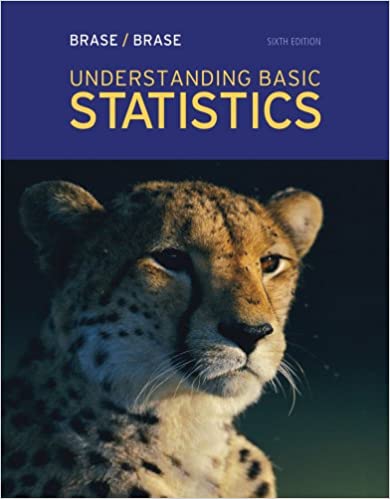
Understanding Basic Statistics 6th Edition by Charles Henry Brase,Corrinne Pellillo Brase
Edition 6ISBN: 978-1111827021
Understanding Basic Statistics 6th Edition by Charles Henry Brase,Corrinne Pellillo Brase
Edition 6ISBN: 978-1111827021 Exercise 55
What is the level of significance State the null and alternate hypothesis.
(b) Check Requirements What sampling distribution will you use What assumptions are you making What is the value of the sample test statistic
(c) Find (or estimate) the P -value. Sketch the sampling distribution and show the area corresponding to the P -value.
(d) Based on your answer in parts (a) to (c), will you reject or fail to reject the null hypothesis Are the data statistically significant at level
(e) Interpret your conclusion in the context of the application. Note: For degrees of freedom d.f. not in the Student's t table, use the closest d.f. that smaller. In some situations, this choice of d.f. may increase the P -value by a small amount and therefore produce a slightly more "conservative" answer. Answers may vary due to rounding.
Vehicle: Mileage Based on information in Statistical Abstract of the United States (116 th Edition), the average annual miles driven per vehicle in the United States is 11.1 thousand miles, with 600 miles. Suppose that a random sample of 36 vehicles owned by residents of Chicago showed that the average mileage driven last year was 10.8 thousand miles. Does this indicate that the average miles driven per vehicle in Chicago is different from (higher or lower than) the national average Use a 0.05 level of significance.
(b) Check Requirements What sampling distribution will you use What assumptions are you making What is the value of the sample test statistic
(c) Find (or estimate) the P -value. Sketch the sampling distribution and show the area corresponding to the P -value.
(d) Based on your answer in parts (a) to (c), will you reject or fail to reject the null hypothesis Are the data statistically significant at level
(e) Interpret your conclusion in the context of the application. Note: For degrees of freedom d.f. not in the Student's t table, use the closest d.f. that smaller. In some situations, this choice of d.f. may increase the P -value by a small amount and therefore produce a slightly more "conservative" answer. Answers may vary due to rounding.
Vehicle: Mileage Based on information in Statistical Abstract of the United States (116 th Edition), the average annual miles driven per vehicle in the United States is 11.1 thousand miles, with 600 miles. Suppose that a random sample of 36 vehicles owned by residents of Chicago showed that the average mileage driven last year was 10.8 thousand miles. Does this indicate that the average miles driven per vehicle in Chicago is different from (higher or lower than) the national average Use a 0.05 level of significance.
Explanation
(a)
(b)
We use the sampling distribu...
Understanding Basic Statistics 6th Edition by Charles Henry Brase,Corrinne Pellillo Brase
Why don’t you like this exercise?
Other Minimum 8 character and maximum 255 character
Character 255


